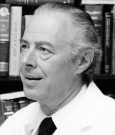One of the early giants in the field of cancer prevention, Lee W. Wattenberg, MD, published in 1966 what would be regarded as a landmark paper in the American Association for Cancer Research (AACR) journal Cancer Research. During his research, he reviewed 36 years of animal studies, looking at the effects of various compounds on carcinogenesis, which set forth the framework for understanding how these compounds worked. It was in this seminal paper that Dr. Wattenberg introduced the term “chemoprophylaxis.”
Dr. Wattenberg contributed prolifically to the scientific literature, constantly advancing the field of cancer prevention. He would later investigate two categories of chemopreventive agents: synthetic compounds that might prevent carcinogen-induced lung cancer and dietary constituents, such as the cruciferous plants cabbage and broccoli.
He also studied the processes that cause irreversibility in carcinogenesis and sought to determine whether and how these processes could be targeted for intervention. Adding to his list of research accomplishments, Dr. Wattenberg also pioneered the use of aerosols to deliver drugs in lung cancer.
Dr. Wattenberg was President of the AACR from 1992 to 1993 and was elected as a Fellow of the AACR Academy in 2013. His many contributions to the AACR included terms as Associate Editor for Cancer Research and Cancer Epidemiology, Biomarkers & Prevention. Dr. Wattenberg also served on the AACR Board of Directors from 1985 to 1988 and from 1991 to 1994. During his presidency, he launched the Associate Member Council in 1992 to represent the interests of early-career scientists.
In a tribute to Dr. Wattenberg, Margaret Foti, PhD, MD, Chief Executive Officer of the AACR, noted, “About two-thirds of all cancers are preventable. Because of Lee Wattenberg’s dedication to and belief in the promise of cancer prevention, the field has taken its rightful place as one of the most important areas of cancer research.” ■


